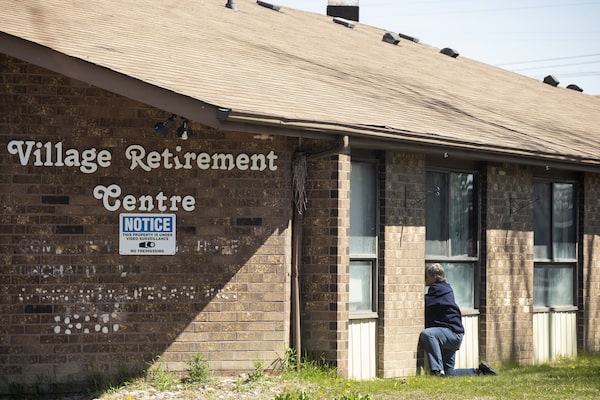
A woman tries to speak to her mother through a window at Orchard Villa Care home in Pickering, Ont., on April 25, 2020.Chris Young/The Canadian Press
Ontario long-term care homes, where the majority of residents have third or fourth COVID-19 vaccine doses, have been spared mass deaths during the Omicron wave despite infection levels similar to those seen in early 2020, according to new figures from the province.
The sector has seen thousands of deaths since the pandemic began and the arrival of the highly contagious Omicron variant late last year raised fears of further devastation.
New data from the province shows 6,572 residents caught the virus between Dec. 15 and Jan. 29 – more than the 6,001 infections confirmed during the first wave that ended in August 2020. Despite that, 251 deaths were reported during that time, compared with 1,940 deaths during the first wave.
The province provided a breakdown on the vaccination status of those who recently died in long-term care – out of the 220 residents who died between Jan. 2 and Jan. 29, only one was a resident with four doses of a COVID-19 vaccine.
Thirty-two of the residents who died were unvaccinated, two had one dose, 36 had two doses and 149 had three doses, according to the figures based on analysis from Public Health Ontario.
The data also shows, however, that a total of 4,810 residents – out of 73,576 in long-term care – had no doses of a COVID-19 vaccine at the end of January.
The Ministry of Long-Term Care said the province took “swift action” to protect against Omicron, pointing to the push for resident fourth doses in December, increased testing and mandating third doses for staff.
“The measures the government have put in place are working and we will continue to closely monitor the situation in long-term care homes and adjust measures as necessary,” ministry spokesman Mark Nesbitt said in an email.
Ontario made long-term care residents eligible for fourth vaccine doses at the end of December as Omicron became the dominant virus strain, and four shots appeared to show the strongest protection against illness and death. The province said 36 long-term care residents with four doses were infected last month.
A top Canadian expert in geriatric medicine said the figures demonstrate the value of fourth doses for those in long-term care but said the province could have done more to administer both third and then fourth shots with greater urgency.
“There was a lot of preventable death that could have been avoided,” Dr. Samir Sinha said in an interview.
The data shows that 33,379 long-term care residents had third shots as of Jan. 31 and 30,867 had fourth doses.
Sinha, the director of geriatrics at Sinai Health and the University Health Network in Toronto, said the province could have taken more focused steps to ensure booster uptake when third shots became available to long-term care residents in August.
Instead, he said, the sector was “playing catch-up” in December when the threat of Omicron became apparent, at which time public health resources were already strained with campaigns to vaccinate young children and all adults with third doses.
By January, long-term care homes in the province were reporting record-high numbers of COVID-19 cases and outbreaks.
Sinha credited existing levels of vaccination in long-term care for the lower death rate during the Omicron wave.
But he said “collateral damage” that did occur – including isolation and other issues that he argued stemmed from understaffing during outbreaks – could have been prevented with a more robust vaccine rollout.
Greater access to third shots for workers could also have prevented some of the hardships, he said. The province has mandated third shots for long-term care workers but pushed a January deadline to mid-March following outbreaks and staffing challenges from Omicron.
Sinha also said he was “shocked” that nearly 5,000 long-term care residents – considered among those at highest risk of severe outcomes from COVID-19 – had no vaccinations at all at the end of January, more than a year after immunizations began in the sector.
Efforts to further vaccinate long-term care homes should continue, Sinha said, especially as the province pushes to roll back COVID-19 measures like proof-of-vaccination rules and masking in much of society over the next few months.
“The data has shown there’s a heck of a lot of catching up to do,” he said.